Content
- The ASI is facing a credibility crisis
- Indians least concerned about the global economy: PEW survey
- How have deception techniques evolved?
- 130th Constitutional Amendment Bill
- ISRO holds air-drop test for Gaganyaan mission
- Cryptocurrency: unlocking the digital vaults
- Is India underestimating the cost of dealing with invasive species?
- Integrated Air Defence Weapon System (IADWS)
- India and the world in dairy
- Arctic sea ice melting has slowed, but here is why this isn’t ‘good news’
The ASI is facing a credibility crisis
Basics: What is ASI?
- Archaeological Survey of India (ASI): Premier national body under the Ministry of Culture, responsible for archaeological research, excavation, and conservation of monuments in India.
- Mandate:
- Excavation of ancient sites.
- Preservation of monuments.
- Publication of findings.
- Guiding India’s official archaeological narrative.
Relevance : GS 1(Culture , Heritage)

The Keeladi Excavation
- Location: Near Madurai, Tamil Nadu (Vaigai river valley).
- Started: 2014.
- Findings:
- Around 7,500 artefacts uncovered in initial phases.
- Evidence of urban, literate, secular society.
- Bridged gap between Iron Age (12th–6th BCE) and Early Historic Period (6th–4th BCE).
- Suggested part of the second urbanisation of India (6th–2nd BCE).
- Significance: Challenges the North-centric narrative of early Indian urbanisation → highlights ancient Tamil civilisation’s sophistication.
- Scholars began calling it the “Vaigai Valley Civilisation”.
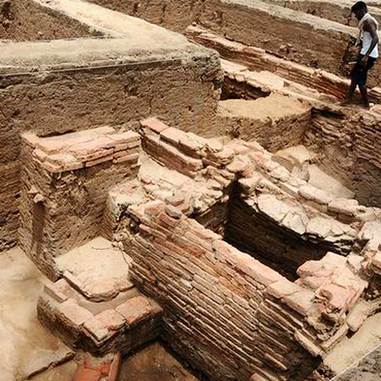
The Controversy
- 2017: Lead archaeologist K. Amarnath Ramakrishna was abruptly transferred to Assam → perceived as an attempt to downplay findings.
- ASI halted excavation, claiming “no significant findings”.
- Sparked a political conflict between Tamil Nadu government and the Union government.
- Madras High Court intervened → excavation handed to Tamil Nadu State Department of Archaeology.
- State-led excavations (2018 onwards) → over 18,000 artefacts unearthed.
Scientific Dispute
- 2023 Report by Ramakrishna: Substantiated early findings with
- Stratigraphic sequencing.
- Material culture analysis.
- Accelerator Mass Spectrometry (AMS) dating → confirming antiquity of artefacts.
- ASI Response: Asked for “revision” of report → accused of political interference.
- Issue highlights politics within archaeological practice and credibility crisis of ASI.
Broader Pattern of ASI’s Conduct
a) Tamil Nadu Sites
- Adichanallur (Thoothukudi):
- Excavated 1900s, revived in 2004 by ASI.
- Iron Age artefacts (3,000+ years old).
- Findings delayed for 15 years, published only after court intervention.
- Sivagalai (Thoothukudi): Similar neglect in publishing findings.
b) Rajasthan Site (Bahaj Village):
- Unearthed 23m-deep paleochannel → linked by ASI to mythical Saraswati River.
- Report claimed links to “Mahabharata period”.
- Example of mytho-historical narrative embraced without rigorous scientific basis.
Key Criticisms of ASI
Institutional Problems:
- Arbitrary transfers & politicisation (e.g., Keeladi case).
- Delayed publication of findings.
- Reliance on outdated Wheeler method (grid system excavation).
- Lack of comprehensive research design.
- Closed internal review system – most findings stay in internal reports, not peer-reviewed journals.
Academic Critiques:
- Ashish Avikunthak (2021): Bureaucratic hurdles, poor infrastructure, stifled research environment.
- Supriya Verma & Jaya Menon (2003): Ayodhya excavation lacked scientific rigour.
- Dilip K. Chakrabarti, Jürgen Neuß: ASI stuck in outdated methodologies, fails in holistic interpretation.
Contrast with Global Practices:
- Institutions in Germany (Deutsches Archäologisches Institut), France (INRAP), Japan (Agency for Cultural Affairs):
- Publish findings in international journals.
- Ensure transparency, accountability, and global engagement.
Conceptual Issue: Methodological Nationalism
- ASI accused of projecting a state-sanctioned, singular narrative of India’s past.
- Characteristics:
- Privileging certain histories (civilisational unity, monolithic antiquity).
- Teleological interpretations (presenting history as linear progress towards modern Indian nationhood).
- Suppressing alternative regional narratives (e.g., Tamil civilisation).
Implications
- Academic: Loss of credibility in global scholarly community.
- Political: Fuels regional vs central tensions (Tamil Nadu vs Union government).
- Cultural: Undermines India’s diverse historical past → promotes homogenised narratives.
- Institutional: ASI faces crisis of legitimacy as an objective scientific body.
Way Forward
- Institutional Reform:
- Greater autonomy from political interference.
- Transparent review & publication system.
- Adoption of modern excavation techniques (remote sensing, digital stratigraphy).
- Decentralisation: Empower state archaeological departments to conduct excavations independently.
- Global Engagement: Publish in peer-reviewed international journals.
- Plural Histories: Recognise India’s regional diversities & multiple civilisational strands, not just a monolithic past.
- Capacity Building: Better training, funding, and infrastructure for archaeologists.
Indians least concerned about the global economy: PEW survey
What is the Pew Research Center Survey?
- Independent US-based think tank → conducts opinion surveys globally on politics, society, and international issues.
- 2025 Survey details:
- Conducted March 24–30, 2025.
- Covered 25 countries (including India).
- Compared with past surveys (2013, 2016, 2017, 2018, 2020, 2022).
- Focused on five perceived global threats:
- Spread of false online information.
- Global economy.
- Climate change.
- Terrorism.
- Infectious diseases.
Relevance : GS 3(Indian Economy)
Global Findings (Across 25 Countries)
- False information online:
- Median 72% → major threat.
- Seen as No. 1 threat in 7 countries (Germany, Netherlands, Poland, Sweden, U.K., U.S., South Korea).
- Global economy:
- Median 70% → major threat.
- For first time since 2017, ranked above climate change.
- Driven by concerns over slowing growth, U.S. tariffs, and ongoing wars.
- Climate change:
- Median 67% → major threat.
- Ideological divide → Left more concerned than Right.
- No country ranked it as top single threat.
- Terrorism:
- Median 69% → major threat.
- Higher concern in middle-income countries (79%) vs high-income countries (60%).
- More concern among older, less educated, and right-leaning populations.
- Infectious diseases:
- Significant concern in Argentina, Brazil, South Africa, Mexico (ranked top threat).
India-Specific Findings
- Terrorism:
- 79% Indians → major threat.
- Among the highest shares globally.
- Similar to Israel, Nigeria, Turkey.
- False online information:
- Close to 70% Indians saw it as a threat → similar to global median.
- Infectious diseases:
- Nearly 70% Indians saw it as a threat.
- Global economy:
- Only 49% Indians → major threat (among the lowest globally).
- Climate change:
- Only 55% Indians → major threat (again among the lowest shares globally).
Contrasts with Advanced Economies (9 Countries)
- Advanced economies (U.S., U.K., Japan, Germany, etc.):
- More concerned about false online information & economy.
- Climate change concern stronger among left-leaning populations.
- India:
- More concerned about terrorism & infectious diseases than economy/climate.
- Reflects security-focused public psyche vs eco-climate anxieties in developed nations.
Reasons for India’s Unique Response
- High terrorism concern:
- Legacy of cross-border terrorism (Pakistan, Afghanistan spillover).
- Domestic insurgencies (Kashmir, Naxal-affected regions).
- Media amplification of security threats.
- Lower climate change concern:
- Climate change seen as long-term/global issue, less immediate.
- Developmental priorities (jobs, poverty, growth) dominate public perception.
- Awareness gap despite frequent heatwaves, floods, air pollution crises.
- Lower economy concern:
- India’s relatively high growth rate (7%+ in recent years) compared to slowing global economies.
- Strong government narrative on resilience of Indian economy may reduce perceived risk.
- False information concern:
- Reflects India’s high social media penetration and rise of misinformation in elections, communal tensions.
Implications of Survey Results
For India:
- Public opinion shaped more by immediate security threats than long-term structural challenges.
- Possible policy-populism gap: Govt needs strong climate & economy focus, even if people under-prioritise them.
- Rising misinformation threat → need for digital literacy, stronger regulation of online platforms.
For Global Governance:
- False information becoming the new universal threat → undermines democracy, trust, and global cooperation.
- Economic anxieties outweighing climate concerns could weaken global climate commitments (e.g., COP negotiations).
- Divergent threat perceptions between rich and middle-income countries complicate multilateral policy alignment.
Way Forward for India
- National security: Continue strengthening counter-terrorism measures.
- Climate change: Improve public awareness linking local disasters (floods, heatwaves) to climate change.
- Economy: Enhance resilience amid global shocks, communicate real risks better.
- Digital governance: Invest in fact-checking, AI moderation, cyber laws.
- Health security: Strengthen pandemic preparedness, integrate infectious disease monitoring.
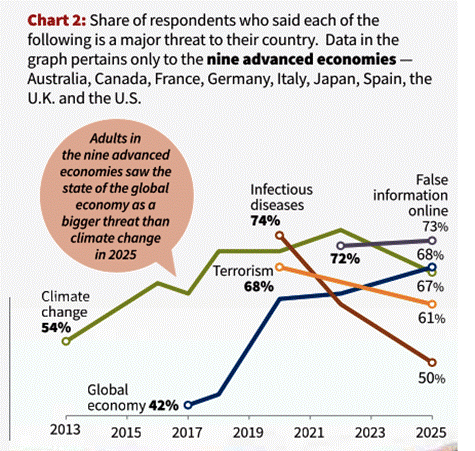
How have deception techniques evolved?
Basics of Decoys in Warfare
- Definition: Deliberate use of fake signatures, objects, or signals to mislead enemy sensors, targeting systems, or decision-making.
- Traditional role: Camouflage, dummy equipment, false troop movements (e.g., WWII inflatable tanks).
- Modern transformation:
- Digital-era electronic spoofing.
- Multispectral deception (radar, thermal, acoustic, infrared).
- AI-enabled decoys.
- Strategic purpose:
- Confuse/saturate enemy targeting systems.
- Waste enemy munitions.
- Protect high-value assets (fighters, ships, tanks).
- Provide time for counter-manoeuvre or retaliation.
Relevance : GS 3(Internal Security , Defence)
India’s Deployment of Decoys
Air Force: Fibre-Optic Towed Decoy (FOTD) – X-Guard
- Context: Used during Operation Sindoor by IAF Rafales.
- Function:
- Trailed ~100m behind aircraft.
- Mimics Radar Cross-Section (RCS), Doppler velocity, and spectral signature.
- Integrated with Rafale’s SPECTRA EW suite.
- Generates 360° jamming signals.
- Impact:
- PAF J-10C fighters misidentified decoys as real Rafales.
- Wasted PL-15E beyond-visual-range missiles.
- Possibly led PAF to wrongly claim shootdowns.
- Significance:
- First known operational Indian use of AI-enabled aerial decoys.
- India seeking emergency procurement of more units.
Comparable Global Systems
- Leonardo’s BriteCloud (Eurofighter, Gripen-E, F-16).
- Raytheon/BAE’s AN/ALE-50/55 (F/A-18).
- Adaptations possible for UAVs (Heron, MQ-9 Reaper).
Navy: Torpedo and Missile Decoys
- INS Karanj (Scorpene-class submarine):
- Equipped with state-of-the-art torpedo decoy system.
- Creates misleading acoustic signatures to divert incoming torpedoes.
- Surface warships:
- Use floating chaff, acoustic decoys, offboard active deception systems.
- Comparable to Nulka decoy (Australia-U.S.) → mimics radar signature of larger ship, diverts anti-ship missiles.
Army: Land-Based Decoys
- Current use: Inflatable, radar-reflective, and heat-emitting dummies (tanks, artillery, missile batteries, command posts).
- 2025 RFI (Request for Information):
- For decoys replicating T-90S/SK tanks.
- Must mimic dimensions, thermal, and acoustic signatures.
- Aimed at confusing enemy drones, loitering munitions, precision-guided missiles.
- Comparisons:
- Russia’s Inflatech → simulates entire armoured brigades.
- Ukraine’s wooden/3D-printed fakes → drain Russian missile stocks.
- U.S. decoy vehicles tested against Javelin ATGMs.
- China → extensive investment in camouflage & deception.
How the X-Guard FOTD Works (Mechanics)
- Weight: ~30 kg, retractable, reusable.
- Functions:
- Projects false RCS & velocity → radar thinks it’s a real aircraft.
- Replicates onboard ECM signals of Rafale.
- Creates a convincing phantom aircraft for human operators & AI targeting systems.
- Integration with SPECTRA EW suite:
- SPECTRA detects threats, manages jamming.
- X-Guard acts as an expendable decoy shield.
Importance of Decoys in Modern Warfare
- Asymmetric advantage:
- Decoys cost a fraction of real platforms.
- Force enemy to expend expensive munitions.
- Multi-domain necessity:
- Air: Protects 4th/5th gen fighters against advanced radar-guided missiles.
- Land: Protects tanks/artillery against drones, PGMs, ATGMs.
- Sea: Protects ships/submarines against anti-ship missiles, torpedoes.
- Future trajectory:
- AI-enhanced autonomous decoys.
- Networked deception swarms (air & sea drones).
- Greater role in countering drone/loitering munition saturation.
Strategic Implications for India
- Operational: Enhances survivability of high-value platforms (Rafales, Scorpenes, T-90s).
- Economic: Low-cost, high-return investment.
- Psychological: Creates fog of war, undermines enemy confidence.
- Defensive posture: Especially critical against Pakistan’s and China’s advanced missile/drone arsenals.
- Industrial opportunity: Scope for domestic R&D in decoys under Atmanirbhar Bharat.
Global Lessons for India
- From Ukraine: Low-cost decoys can exhaust superior adversaries.
- From U.S./Australia: Offboard, independent decoys (like Nulka) vital for naval survival.
- From Russia/China: Mass deployment of fake formations creates operational paralysis for enemies.
Conclusion
- Decoys have moved from supplementary camouflage to a strategic asset equal to firepower.
- India’s adoption of X-Guard, torpedo decoys, and land-based fakes indicates recognition of this trend.
- The future battlefield will likely see AI-enabled swarms of decoys operating alongside real systems, blurring the line between illusion and reality.
130th Constitutional Amendment Bill
Context of Criminalisation of Politics
- Definition: Entry and participation of individuals with criminal background in legislative and executive positions.
- Magnitude (ADR Data):
- 46% of sitting MPs and 45% of MLAs face criminal cases.
- Candidates with criminal records have 15.4% chance of winning vs 4.4% for clean candidates.
- Consequences:
- Weakens democracy, undermines rule of law.
- Promotes muscle-power & money-power in elections.
- Public distrust in political institutions.
Relevance : GS 2(Polity , Constitution )
Existing Legal Framework
- Representation of the People Act (RP Act), 1951:
- Section 8: Disqualification on conviction if sentence ≥ 2 years.
- Applies for entire sentence duration + 6 years post-release.
- Section 8(4): Earlier allowed MPs/MLAs to continue in office if appeal was filed → struck down in Lily Thomas (2013) case.
- Current gap: Law disqualifies MPs/MLAs from being legislators, but no explicit provision for disqualification from being a minister (PM/CM or cabinet).
What does the 130th Constitutional Amendment Bill propose?
- Amendments: To Articles 75, 164, and 239AA (Union Council of Ministers, State Council of Ministers, and NCT of Delhi).
- Key provisions:
- If a Minister is arrested and detained for 30 consecutive days in connection with an offence punishable with ≥ 5 years imprisonment, they must be removed.
- Process:
- Removal based on advice of PM/CM.
- If no advice is given, automatic cessation from office on 31st day.
- PM/CM themselves: Must resign on 31st day if detained ≥ 30 days.
- Once released, they can be re-appointed.
- Extension: Similar provisions proposed for J&K and Puducherry.
- Procedure: Needs 2/3rd majority in both Houses (since constitutional amendment).
Rationale Behind the Bill
- Address criminalisation of politics by ensuring that individuals facing serious criminal charges do not hold executive authority.
- Prevent misuse of executive power by tainted ministers during investigation/trial.
- Bring executive disqualification in line with legislative disqualification norms under RP Act.
Issues and Criticisms
- Undermines Parliamentary Democracy:
- PM/CM should have freedom to choose their council of ministers (basic feature of Constitution).
- External restriction weakens this discretion.
- Police Action Before Trial:
- Even without conviction, mere arrest + detention for 30 days leads to removal.
- Violates principle of “innocent until proven guilty”.
- Scope for Misuse:
- Governments may misuse police machinery to arrest opposition ministers.
- Particularly dangerous in Centre–State conflicts (e.g., opposition-ruled states).
- Temporary Nature:
- Ministers can be reappointed after release → little real deterrent effect.
- Focus on Effect, Not Cause:
- Bill addresses ministers already in office, not selection of candidates.
- Real issue: Political parties nominating tainted individuals in the first place.
Alternatives and Reforms Needed
- Election Commission’s 2016 Recommendation:
- Bar candidates from contesting elections once charges are framed by a competent court for offences punishable ≥ 5 years.
- Judicial Oversight: Safeguards against frivolous cases (screening by independent judicial body before disqualification).
- Political Party Responsibility:
- Stop giving tickets to candidates with criminal background.
- Supreme Court (2018, 2020 judgments): Parties must publicly justify selection of candidates with criminal cases.
- Voter Awareness: Strengthening disclosure norms under affidavits (Form-26).
- Fast-Track Courts: To decide cases against MPs/MLAs quickly → prevent prolonged uncertainty.
Strategic Implications
- Positive:
- Symbolic move against corruption & criminalisation.
- May enhance executive accountability.
- Negative:
- Weakens federalism, creates potential for political vendetta.
- Risks destabilisation of governments through misuse of arrests.
Conclusion
- The 130th Constitutional Amendment Bill reflects India’s attempt to tackle criminalisation of politics, but it risks constitutional overreach and misuse.
- True reform lies in preventing criminal candidates from entering politics, not only in removing them after being elected/appointed.
- A balanced approach requires:
- Judicial safeguards,
- Political party self-discipline,
- Electoral reforms (pre-screening of candidates),
- Strengthening institutional mechanisms like ECI and judiciary.
ISRO holds air-drop test for Gaganyaan mission
Gaganyaan Mission
- Objective: India’s maiden human spaceflight mission.
- Timeline: Targeted for execution in coming years (preparatory missions ongoing).
- Goal: To send a 3-member crew to low-Earth orbit (LEO) (~400 km altitude) for 3 days and bring them back safely.
- Agencies involved: ISRO (lead), Indian Air Force, Navy, Coast Guard, DRDO.
Relevance : GS 3(Space)
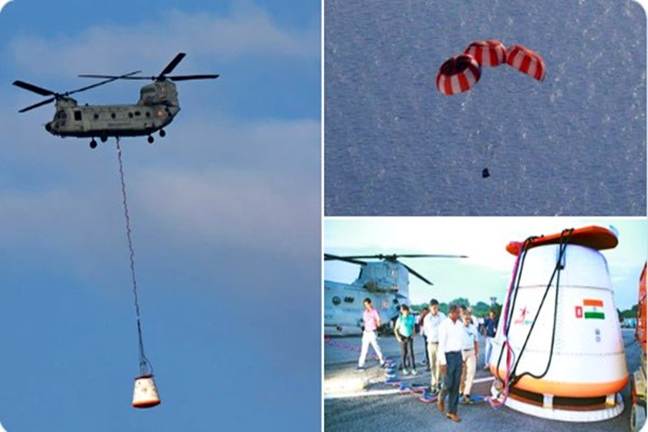
What is the IADT (Integrated Air Drop Test)?
- Purpose: End-to-end demonstration of parachute-based deceleration system for crew module recovery.
- Why important: Safe descent and splashdown are critical risk phases in human spaceflight.
- Process:
- A dummy crew capsule (~5 tonnes) was lifted by an Indian Air Force Chinook helicopter.
- Capsule released mid-air → descended from a few km altitude.
- Drogue parachutes deployed first to stabilise → followed by sequential deployment of main parachutes.
- Parachutes slowed capsule for safe splashdown speed.
Critical Systems Involved
- Crew Module (CM): Houses astronauts. Requires controlled descent and recovery.
- Parachute Recovery System: Designed for redundancy (multiple parachutes to ensure safe deceleration).
- Crew Escape System (CES): 5 types of solid motors tested; ensures astronauts can escape in case of launch failure.
- Environmental Control & Life Support System (ECLSS): Provides oxygen, pressure, and climate control inside capsule.
Significance of IADT-1
- Validation step: Proves reliability of parachute-based deceleration and recovery system in near-real conditions.
- Human-rating of systems: Essential before flying astronauts. Ensures safety compliance.
- Cross-agency coordination: Demonstrates synergy between ISRO, IAF, DRDO, Navy, Coast Guard for recovery operations.
- Infrastructure readiness: Facilities like crew training centres, control centres, and modified launch pads already established.
Why Recovery Phase is High Risk
- Atmospheric re-entry: Capsule faces extreme heat, requiring robust heat shields.
- Descent dynamics: High velocity (~7–8 km/s in orbital return) must be reduced drastically.
- Splashdown precision: Capsule must land safely at pre-identified zones in sea for Navy recovery.
- Human safety: Even minor failure in parachutes/ECLSS can risk astronaut lives.
Preparatory Steps Before Human Flight
- Unmanned Test Missions:
- Test vehicle flights (abort & escape systems).
- Pad Abort Tests (crew escape reliability).
- IADT series: More tests to validate parachute deployments at different conditions.
- Orbital Module Preparation Facility: Readying crew and service modules.
- Crew training: Indian astronauts undergoing training in Russia + advanced training in Bengaluru.
Strategic Significance
- India’s entry into human spaceflight club: After USA, Russia, and China.
- Boost for indigenous aerospace tech: Parachutes, life-support, CES—all indigenously developed.
- Spinoffs: Enhanced capabilities in re-entry vehicles, space tourism, future lunar missions.
- National prestige & soft power: Strengthens India’s standing as a space power.
Cryptocurrency: unlocking the digital vaults
What is Cryptocurrency?
- Etymology: Derived from Greek word “kryptos” = hidden/secret.
- Definition: Digital or virtual currency that uses cryptography for security.
- Nature:
- Not physical (can’t be touched/seen).
- Stored in virtual wallets (software or hardware).
- Not controlled by RBI, SEBI, or Govt. of India – fully decentralised.
- Medium: Works on decentralised computer networks (nodes).
- Transactions: Peer-to-peer (P2P), no banks/intermediaries required.
- Example: Bitcoin, Ethereum, Solana, etc.
Relevance : GS 3(Economy – Currencies)
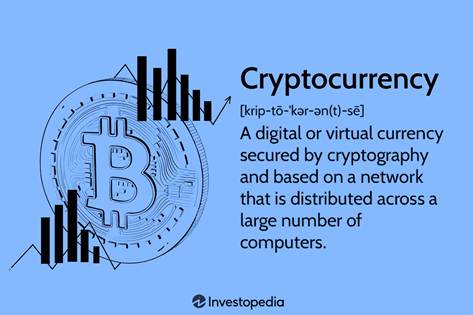
How is it Different from Traditional Money?
- Traditional Currency:
- Regulated by central banks (RBI, Federal Reserve).
- Physical + digital form.
- Requires intermediaries (banks, payment gateways).
- Transactions can be altered/reversed.
- Cryptocurrency:
- Decentralised, no central regulator.
- Purely digital, secured by cryptography.
- Transactions are irreversible and recorded permanently.
- Runs on blockchain technology.
What is Blockchain? (The Backbone of Crypto)
- Definition: A decentralised, digital, distributed ledger storing all transaction history of a cryptocurrency.
- Analogy:
- Like a global accountant’s notebook + Google Sheet shared with everyone.
- Every page = a block.
- Once a block is filled, it is time-stamped, sealed, and linked to the next via a hash (unique code).
- Together, they form a chain of blocks = blockchain.
Key Features of Blockchain
- Transparency: Anyone can view transactions.
- Immutability: No one can delete/alter past records.
- Security: Encrypted and verified by multiple nodes.
- Decentralisation: No central authority.
- Trustless System: Transactions validated by code, not institutions.
How Do Transactions Work?
- Initiation: Ram sends a crypto coin to Shyam.
- Bundling: This transaction + previous ones grouped into a block.
- Validation: Nodes verify authenticity using cryptography.
- Linking: Once block is full → sealed with hash → linked to previous block.
- Updating: Blockchain updated across all nodes instantly.
- Example analogy: Shared Google Sheet where everyone can see entries, add new ones, but no one can delete past data.
Why Do People Invest in Crypto?
- High returns: Potentially exponential growth (e.g., Bitcoin rise since 2009).
- Borderless: Works across countries, independent of banks.
- Transparency & security: Immutable records.
- Diversification: Alternative asset class beyond stocks, gold, real estate.
- Utility: Used for payments, smart contracts (Ethereum), NFTs, DeFi.
Risks and Challenges
- Volatility: Prices fluctuate wildly (e.g., Bitcoin crashed >70% in 2022).
- Regulatory uncertainty: India, US, EU still evolving laws.
- Security threats: Hacks, scams, phishing, wallet theft.
- No consumer protection: Unlike banks, no recourse for fraud/loss.
- Speculative nature: Without knowledge, investment = gambling.
India and Cryptocurrency
- Adoption: Millions of Indians hold crypto assets.
- Payments: Some firms accept crypto payments globally.
- Regulation:
- Not legal tender in India.
- 30% tax on crypto gains (since Union Budget 2022).
- 1% TDS on transactions.
- Future: India exploring CBDC (Central Bank Digital Currency) as regulated alternative.
Why Blockchain is Revolutionary (Beyond Crypto)
- Applications:
- Banking & finance (faster, transparent settlements).
- Supply chains (track authenticity).
- Healthcare (secure patient records).
- Governance (land records, e-voting).
- NFTs & Metaverse (digital ownership).
Is India underestimating the cost of dealing with invasive species?
Basics: What are Invasive Alien Species (IAS)?
- Definition: Non-native plants, animals, or microbes introduced (intentionally/unintentionally) into a new ecosystem where they outcompete native species.
- Pathways of spread:
- Global trade (timber, crops, live animals, plants).
- Shipping (ballast water, hull fouling).
- Travel and tourism.
- Agriculture, aquaculture, ornamental trade.
- Examples in India: Lantana camara, Prosopis juliflora, Parthenium hysterophorus (Congress grass), African catfish, Golden apple snail.
Relevance : GS 3(Environment and Ecology)
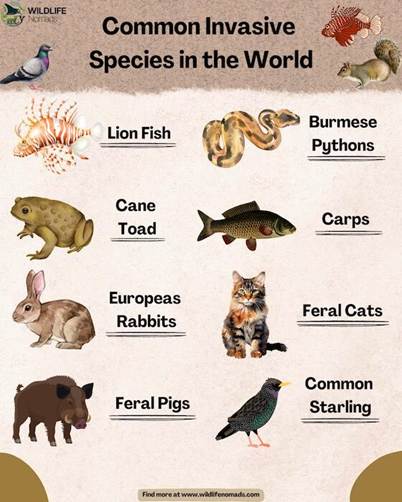
Key Findings of the New Study (Nature Ecology & Evolution, 2025)
- Global economic cost: Over $2.2 trillion (1960–2022).
- Underestimation: Actual costs may be 16 times higher than earlier reported.
- Regional costs:
- Europe: $1.5 trillion (71.4% of global costs).
- North America: $226 billion.
- Asia: $182 billion.
- Africa: $127 billion.
- Australia & Oceania: $27 billion.
- India:
- No exact absolute cost estimated.
- Highest discrepancy in reporting: 1.16 billion % difference in recorded vs. real management expenditure (suggesting hidden/unreported costs).
- Global median discrepancy: 3,241%.
- Europe: 15,044%.
- Asia (excl. India): 3,090%.
- Africa: 1,944%.
Who are the Major Invaders?
- Plants: Largest economic impact, $926.38 billion (1960–2022).
- Example: Lantana camara (covers Bandipur NP, highly combustible).
- Example: Japanese knotweed (Reynoutria japonica) – costly per sq. km.
- Arthropods (insects, spiders, etc.): $830.29 billion.
- Mammals: $263.35 billion.
Impact of Invasive Species
- Economic
- Crop yield loss.
- Forestry destruction.
- Increased fire hazards (lantana).
- Higher management/control costs.
- Ecological
- Displacement of native species.
- Alteration of soil chemistry and water cycles.
- Spread of diseases.
- Reduced biodiversity and ecosystem resilience.
- Social
- Threats to food security.
- Human health impacts (e.g., allergies from Parthenium).
- Higher burden on resource-constrained economies (India, Africa).
Why Underreporting in India?
- Lack of centralised data systems.
- Poor inter-agency coordination (forest, agriculture, fisheries, environment departments).
- Limited funding for monitoring & control.
- Reports in local/regional languages often excluded from global databases (InvaCost bias).
- Competing conservation priorities (e.g., tiger reserves, afforestation drive).
Policy and Management Strategies
- Global treaties:
- Ballast Water Management Convention – prevent spread via shipping.
- Convention on Biological Diversity (CBD) – parties (including India) must prevent, control, or eradicate invasive species.
- Response strategies:
- Prevention of introduction (quarantine, stricter import checks).
- Eradication (if caught early).
- Control & suppression (mechanical removal, biocontrol agents).
- Slow spread management (buffer zones, awareness).
- Challenge: Complete eradication often impractical, since many agricultural crops themselves are non-native.
India-Specific Issues
- High invasion intensity in forests, wetlands, and agricultural landscapes.
- Examples:
- Parthenium in farmlands.
- Prosopis juliflora degrading grasslands.
- Eichhornia crassipes (Water hyacinth) choking wetlands.
- Costs: Hidden/unrecorded, but among the highest globally.
- Need: Centralised national invasive species database, scientific monitoring, integration of invasion control in policies like National Biodiversity Action Plan.
Big Picture Analysis
- Dual challenge:
- Mitigating economic losses & ecological damage.
- Reconciling with globalisation and trade, which accelerates invasions.
- Climate change: Increases invasibility of ecosystems, aiding spread of alien species.
- Way forward for India:
- National-level invasive species action plan.
- Stronger quarantine laws at ports.
- Integration with agriculture and forest policies.
- Regional cooperation (since invasions cross political borders).
Integrated Air Defence Weapon System (IADWS)
Basics
- Air Defence Systems (ADS):
- Designed to detect, track, intercept, and destroy hostile aerial threats (aircraft, UAVs, missiles).
- Can be short-range, medium-range, or long-range.
- In modern warfare, integrated systems combine radars, missiles, guns, lasers, and electronic warfare tools.
- Integrated Air Defence Weapon System (IADWS):
- A multi-layered defence shield being developed by DRDO.
- Successfully completed maiden flight tests off Odisha coast (Aug 24, 2025).
- Part of Mission Sudarshan Chakra (announced by PM Modi on Independence Day 2025).
- Target year: 2035 for full operationalisation.
Relevance : GS 3(Internal Security , Defence , Science and Technology)
Components of IADWS
- Quick Reaction Surface-to-Air Missiles (QRSAM):
- Short-to-medium range missile.
- Mobile, can engage multiple aerial targets quickly.
- Advanced Very Short Range Air Defence System (VSHORADS):
- Portable, shoulder-fired or tripod-based.
- Effective against low-flying aircraft, UAVs, helicopters.
- Directed Energy Weapons (DEW):
- High-power lasers.
- Future-oriented technology for soft kill (jamming, blinding) and hard kill (destroying drones, missiles).
- Surveillance & Cybersecurity Integration:
- Combines radar-based tracking with networked surveillance & cyber defence systems.
- Aimed at intercepting threats across domains (air, cyber, electronic).
Strategic Context
- Why Needed?
- Rising threats from long-range missiles, drones, UAV swarms, stealth aircraft, and cyber warfare.
- China and Pakistan both developing advanced missile systems and UAV capabilities.
- India’s critical installations (nuclear plants, command centres, metro cities, defence bases) require a layered security shield.
- Global Comparison:
- Similar systems:
- US: Patriot & THAAD.
- Russia: S-400, S-500.
- Israel: Iron Dome, David’s Sling, Arrow.
- India is moving towards self-reliant, indigenised solutions instead of heavy dependence on imports.
- Similar systems:
Significance for India
- National Security
- Will provide multi-layered protection at borders and critical infrastructure.
- Better defence against Pakistan’s Nasr missiles and China’s cruise/hypersonic threats.
- Strategic Autonomy (Atmanirbhar Bharat)
- Reduces reliance on foreign systems like Russian S-400.
- Boosts India’s indigenous defence R&D and defence exports.
- Technological Leap
- Integration of cyber, laser weapons, AI-based tracking marks entry into futuristic warfare.
- Enables network-centric warfare capability.
- Private Sector Participation
- Defence organisations + private companies will jointly develop system.
- Encourages growth of Indian defence-industrial ecosystem.
Challenges
- Technology complexity: Directed energy weapons and multi-layered integration are highly advanced fields.
- Costs: Extremely high financial burden; long-term sustained funding required.
- Timelines: Target year 2035 may face delays (common in defence projects).
- Adversary countermeasures: China/Pakistan may develop decoys, electronic countermeasures, or hypersonic glide vehicles.
Big Picture
- The IADWS is a strategic leap towards building a robust, indigenous, multi-layered air defence system.
- Complements India’s existing S-400 system (Russian import), Akash, and other missile defence layers.
- Strengthens deterrence posture, providing credible defensive depth against modern aerial threats.
- Aligns with Atmanirbhar Bharat and India’s ambition to become a global defence exporter.
India and the world in dairy
Basics
- India’s Dairy Sector
- India is the world’s largest milk producer (~22% of global output).
- Milk = key contributor to rural income and nutrition.
- Dairy in India is largely smallholder-driven, unlike large mechanised farms in the US/EU.
- Cooperatives (like Amul/GCMMF) play a major role in procurement, processing, and marketing.
- Global Dairy Trade
- Major exporters: US, EU, New Zealand, Australia.
- Major importers: China, Southeast Asia, Middle East.
- India is mostly self-sufficient; exports are limited.
- Pressure from WTO & bilateral trade deals (esp. US) to open Indian market to global dairy products.
Relevance : GS 3(Agriculture , Dairy Farming)
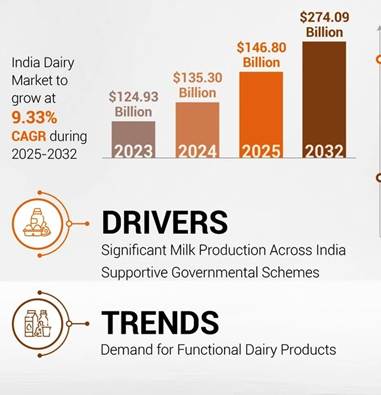
Price Competitiveness
- Comparison with US:
- Example: Corn (feed input) – US farmers get maize at ₹15.4/kg vs ₹22–23/kg in India → lowers US dairy input cost.
- But India’s farm-gate milk price (~₹34/litre for cow milk in Maharashtra) is comparable or lower than US.
- Reason:
- Unpaid family labour in India → keeps costs artificially low.
- India’s low-cost model relies on labour intensity, not productivity.
Efficiency & Value Chain
- Price Transmission:
- In Gujarat, farmers get 45–46 per litre for cow milk (3.5% fat, 8.5% SNF) vs ₹34–35 private dairies pay.
- Farmers share 55–57% of consumer rupee – higher than US (35%).
- Cooperatives compress the value chain → better margins for farmers.
- Processing Efficiency:
- Cooperatives like Amul add value through butter, cheese, ghee, etc.
- Procurement, transport, marketing more integrated in India → efficiency in converting farm milk to retail.
Challenges
- Sustainability of Low-Cost Advantage
- Based on cheap/unpaid labour, not productivity gains.
- As rural wages rise & alternative employment grows, labour-based competitiveness may weaken.
- Input Constraints
- Scarcity of high-quality fodder.
- Small, unviable herd sizes → limited economies of scale.
- Labour-intensive milking (manual), unlike automation in US/NZ.
- Global Competition
- Countries like New Zealand have abundant pastures → cost-effective, grass-fed milk.
- US/EU → high mechanisation, selective breeding, advanced fodder genetics → higher yields.
- Climate & Resource Stress
- Dairying in India is water-intensive (fodder, cattle rearing).
- Climate change may impact feed availability & productivity.
Big Picture: India’s Position
- Strengths:
- World’s largest producer, self-sufficiency.
- Strong cooperative model (Amul success story).
- High farmer share of consumer rupee.
- Weaknesses:
- Cost competitiveness based on low wages, not efficiency.
- Productivity per animal much lower than global standards (India’s ~1,800 litres/year vs US/NZ >10,000 litres/year).
- Poor fodder base & fragmented production.
- Opportunities:
- Genetic improvement (cross-breeding, selective breeding).
- Mechanisation & automation (milking machines, feed technology).
- Fodder innovation (high-yield fodder, hydroponics).
- Dairy exports (value-added products like ghee, paneer, casein).
- Threats:
- Trade liberalisation → cheap US/NZ dairy may undercut Indian farmers.
- Rising labour costs → erode low-cost advantage.
- Climate change & resource pressure.
Arctic sea ice melting has slowed, but here is why this isn’t ‘good news’
Context :
- Arctic Sea Ice
- Floating ice formed from seawater in the Arctic Ocean.
- Seasonal: expands in winter, shrinks in summer.
- Important climate indicator → reflects solar radiation (albedo effect), regulates global climate, supports ecosystems.
- Why It Matters
- Sea ice decline accelerates global warming (less reflection, more heat absorption).
- Impacts global ocean currents, weather patterns, ecosystems, human settlements (sea-level rise indirectly via Greenland).
Relevance : GS 3(Environment and Ecology)
Key Findings of Study
- Conducted by researchers from University of Exeter, Columbia University, UC Irvine.
- Analysed Arctic Sea Ice Loss since 1980s.
- Found: rate of Arctic ice loss has slowed in past 20 years, compared to 1990s.
- BUT: slowdown is due to natural climate variability, not reduced global warming.
Why has Arctic ice loss slowed down?
- Natural variability in climate systems:
- Pacific Decadal Oscillation (PDO), Atlantic Multidecadal Variability (AMV), and ENSO (El Niño–Southern Oscillation).
- These fluctuations alter sea surface temps, circulation, cloud cover, influencing Arctic climate.
- Ice loss reduced from 8.3 lakh sq km per decade (1992–2012) to 3.1 lakh sq km per decade (2003–2022).
Why this is not ‘good news’
- Not a recovery, only temporary
- The slowdown doesn’t mean melting has reversed.
- Ice is still thinning and fragile → makes sudden collapse more likely in the near future.
- Masking the trend
- Natural variability is temporarily offsetting the greenhouse-gas-driven warming.
- Once variability shifts, ice loss could accelerate dramatically.
- No evidence of climate action impact
- The slowdown is not due to reduced CO₂/GHG emissions.
- Thus, policy inaction continues to be dangerous.
- Future Risks
- If melting accelerates again, collapse could be faster than previously modelled.
- This would trigger abrupt climate shifts (feedback loops like methane release, disrupted monsoons, altered jet streams).
Scientific Context
- Arctic amplification: Arctic warms 2–4 times faster than global average.
- Tipping Point Risk: A critical threshold exists beyond which sea ice loss becomes irreversible, even if emissions are reduced later.
- Analogy by scientists: Ice loss is like a ball rolling downhill. Temporary slowdown = ball pauses, but slope ensures it will roll down faster later.
Implications
- For Climate Science
- Need to account for natural variability in climate models.
- Avoid misinterpreting slowdown as progress.
- For Policy
- Reinforces urgency of deep emission cuts.
- Reliance on natural pauses is dangerous.
- For Global Climate Systems
- Faster future melting could disrupt:
- Monsoons (South Asia).
- North Atlantic currents (AMOC).
- Global temperature regulation.
- Faster future melting could disrupt:



